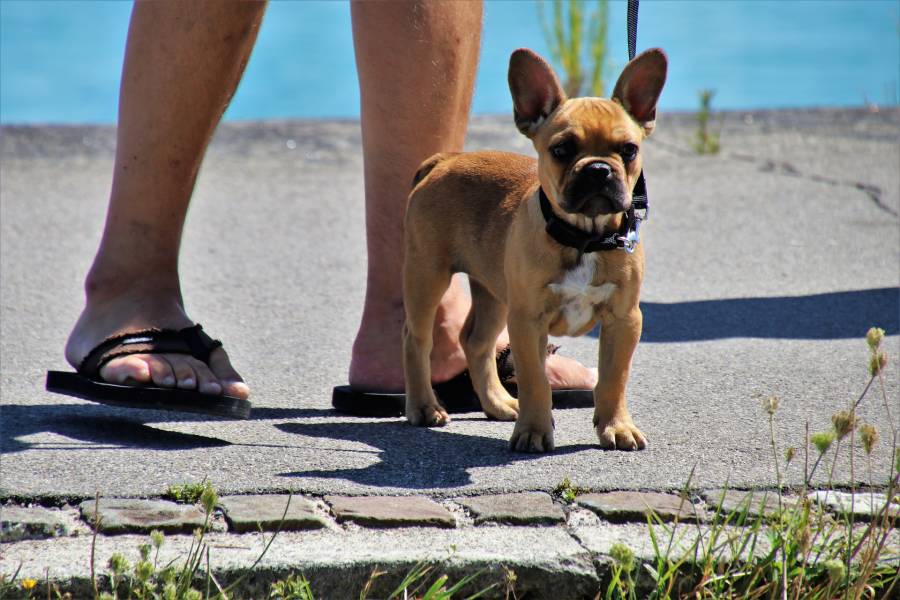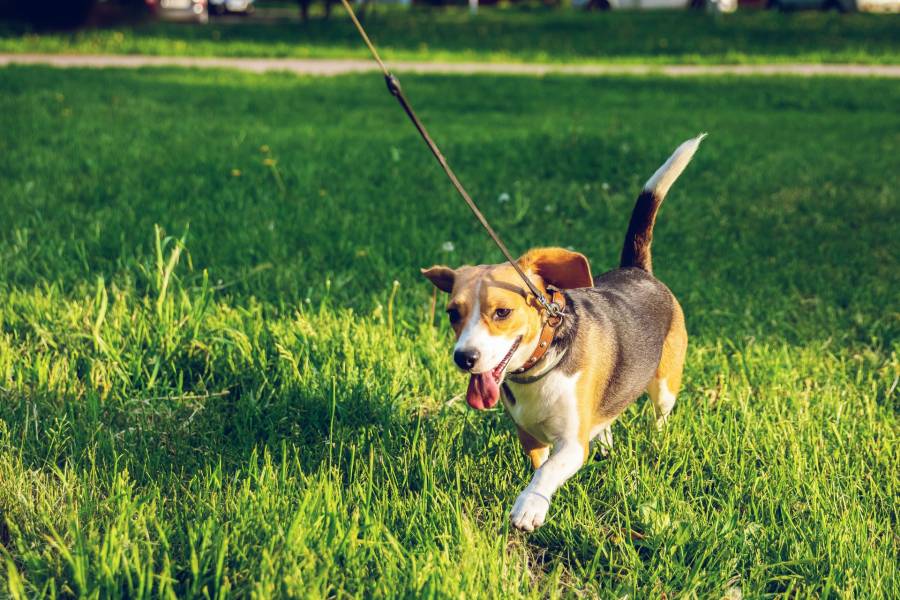Quick Navigation
A puppy walk should be a pleasant experience, but how do you get a puppy used to a leash?
Besides allowing your puppy to exercise and experience a new environment, puppy walks also strengthen your bond.
With reduced pulling and tugging, leashes help make puppy walks safe and comfortable.
For your puppy to walk correctly on a leash, it must first get used to it.

Leash training could take up to a few weeks and your puppy needs time to adjust to the collar around its neck.
Here are some crucial steps to help you get your puppy used to its leash.
Step 1: Introduce The Collar And Leash
For your puppy to get used to a leash, it must first learn to wear a collar or harness comfortably.
The accessory of your choice should be suitable for your puppy’s needs.
Breeds like bulldogs are better off with a harness rather than a collar.
A good collar or harness should be light, wide, flat, and well-fitting to avoid stressing and distracting your puppy while walking.
You should also invest in a high-quality collar or harness to save your dog from unnecessary pain from substandard ones.
1. Place The Collar Or Harness On Your Puppy
When your puppy is calm, gently place the collar or harness on its neck.
The collar or harness should lie underneath the jaw of your puppy and just behind its ears.
Setting it too low may render the collar or harness useless.
- Before clipping the collar or harness behind the dogs’ ears, you should ensure its upright and well-fitting.
You can test this by putting two fingers between the collar and your puppy’s neck. - If the collar is too loose or tight, you should adjust it until your fingers fit snugly.
If your fingers fail to fit snugly even after the adjustments, you should replace the collar. - Your puppy is likely to fuss and squirm, scratching and shaking its head once the collar or harness is on.
This is out of confusion as the puppy is not used to the collar or harness around its neck.
You shouldn’t be worried because your puppy will eventually get used to the collar or harness.
2. Distract Your Puppy With Something Fun
Distracting your puppy with a fun activity helps prevent it from fussing in reaction to the collar or harness.
Here are some tips to get your puppy distracted after fitting the collar or harness to its neck.
- Play an interactive game with your puppy.
Interactive games like rolling and chasing a ball on the floor will help it forget about the collar or harness. - When your dog fusses after fitting the collar or harness, you can hug it to help it calm down.
- The collar or harness might trigger stress on your dog.
Massage its neck, shoulder, and legs to relieve it from any stress - Put the collar or harness on your puppy right before mealtime, so your puppy will be distracted with eating while it’s on.
- Consider putting the collar or harness on before playtime.
Your puppy will be so busy playing afterward that it will forget about its collar or harness.
3. Monitor the Amount of Time Your Puppy Wears the Collar or Harness
To get your puppy used to the collar or harness, you should practice several times.
During each practice session, your puppy should stay with the collar or harness for 5 minutes before removing it.
You can increase the minutes gradually over the next two weeks.
There should also be a 45 minutes break in between the sessions.
- It is not advisable to subject your puppy to wear the collar or harness all day.
Puppies love to run and play around a lot.
The collar or harness can get caught, putting your puppy in danger.
It should only be worn during practice sessions. - Always ask for more guidance from animal experts if you are unsure about your leash training.

4. Take the Collar or Harness Off
Always wait until your puppy is calm before taking the collar or harness off.
If you take it off during fuss, your puppy might think you reward their fights by taking the collar or harness off.
They might adapt to this behavior, making their leash training difficult.
Some aggressive puppies might bite you when frustrated with the collar or harness.
Before removing the collar or harness, consider giving your puppy food or playing with them to distract them.
Remember to reward your puppy during the training process.
Treats can get your puppy used to its collar or harness faster.
Giving the treats in small amounts that your puppy can chew quickly would be best.
Some best moments to give treats when collar training your puppy include:
- Immediately after putting the collar or harness on, puppies think that wearing the collar or harness is a great thing.
- While has the collar or harness: this will distract your puppy.
Step 2: Getting Your Puppy Used To The Leash
Once your puppy is comfortable with the collar or harness, you must introduce it to a leash.
With proper leash training, your puppy will learn and develop good habits that will help them avoid pulling or pouncing on other animals and people while walking outdoors.
Here are some great tips to help you get your puppy used to a leash.
1. Select A Beginner Leash For Your Puppy
Your puppy’s first leash should be simple, lightweight, and without a loop. As your puppy grows, you will need a bigger and heavier leash.
You might use a rope from the hardware instead of an actual loop. If you are using an actual loop, you should cut the loop out to prevent your puppy’s paws from getting stuck in the loop.
2. Attach the Leash to the Collar or Harness
After obtaining the right leash, you need to attach the leash to the collar or harness and let your puppy drag the leash around the house.
Like with the collar and harness, your puppy might get overwhelmed by the leash.
To get your puppy used to the leash, let it move around for about 15 minutes.
Watch your puppy closely because the leash can easily get caught by something, causing your dog to panic.
- Do not hold the leash at the beginning.
Let your puppy drag it around until it gets comfortable with the leash pressure on its neck. - Attach the leash in a safe and familiar room in the house a few times per day without holding it.
3. Distract Your Puppy
If your puppy seems to get squirmy or fussy with the leash, you can calm it down by distracting it.
Command them to obey or offer toys or food to draw their attention away from the leash.
You should put the leash before playtime, and it is an excellent way of tricking your puppy into associating the leash training with some fun activity.
4. Take The Leash Off
After the training sessions, wait until your puppy is calm before taking the leash off.
Refrain from rewarding your dog after taking the leash off.
Step 3: Walking Your Puppy On A Leash
Once your puppy is comfortable walking around with the leash and dragging it around, you can start walking it on a leash.
Here are some significant steps to help you get your puppy used to walking on a leash.
1. Pick Up The Leash
After putting the leash and collar or harness on your puppy, gently pick the leash from one end and start walking with your puppy.
At this point, your puppy is not ready for outdoor walks, so you should practice walking with it at home.
While walking, ensure you keep the leash at your waist height while encouraging and commending the puppy for an excellent job.
2. Let Your Puppy Lead You
Once you pick the leash, your dog will not immediately start walking beside you.
Allow it to lead you while it gets used to you holding the leash.
Don’t pull the leash as your puppy might start pulling back, getting injured.
In case your puppy starts pulling, don’t yank the leash.
Instead, turn and walk in a different direction.
3. Get Your Puppy Used To Walk Beside You
During puppy walks, your puppy should always walk beside you, not in front of you.
To encourage your puppy to heel, give it treats as it walks beside you. This way, it will learn that walking beside you is good.
What To Do if You Are Having Trouble With Leash Training
Leash training takes time, and maybe your puppy has already gotten used to a leash until it is in a new environment, giving you some problems along the way.
So if your pup starts pulling you in a direction you don’t want to go, you might be tempted to drag your dog or yank its leash.
However, don’t do them.
Instead, stand very still and refuse to move after your dog.
Establish between you that you are the one who calls the shots and not your dog.
If your dog gets distracted by another dog or someone you meet along your walks, redirect your dog’s attention before they decrease the space towards what’s distracting them.
So when walking your dog, you must be alert about these things and not be caught off guard when your pup gets distracted.
And just like when your pup gets distracted, it may be accompanied by a bark.
To keep this from happening, you can also distract your pup with some treats and create some distance between your dog and the source of its distraction.
Summary
- Getting your puppy used to a leash and collar takes time and patience, but the effort is worth it.
- The best time to begin leash training your puppy is when they are around 4-6 weeks old.
- At this age, they will quickly get used to the leash.
- When leash training your puppy, it is most likely to obey you when your voice is calm and quiet, not an angry tone.

A passionate content creator on pet behavior, nutrition choices, and health, Mike is an experienced pet expert. He has been writing on multiple websites to compensate for his passion for cats. Mike grieves around plenty of pets in his parents’ house. At the start of his career, he had a sturdy intention to be a part of pet care by any means.
With his affiliation to Purrfect n’ Pawesome, he found a way to satiate his craving to participate in pet health, wellness, and behavior analysis. He has been a significant part of our team and a major contributor in equipping our site with useful, authentic, and research-backed articles.
“I love pets as much as I love to travel to explore multiple places and lifestyles. I have been attached to this pawsome platform for many years, and my experience regarding pets has enhanced significantly by using various devices to write articles. I believe in writing my thoughts and experiences, so I try to write down the experience and learnings for my readers no matter where I am and what my mood is.”
